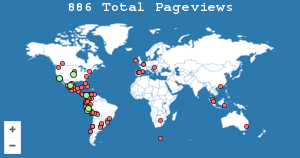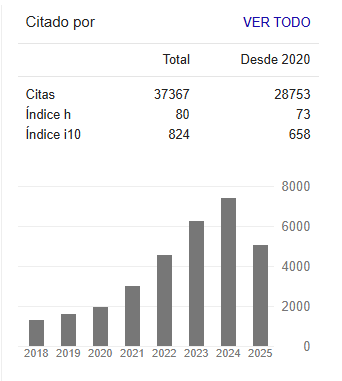Categorización del turista patrimonial. El caso de Granada (España)
Resumen
Las razones variadas por las cuales un individuo toma la decisión de viajar o hacer turismo desencadenan la necesidad de conocer y profundizar en las características de los diferentes tipos de turistas, con preponderancia en países y ciudades cuya economía se dinamiza gracias a este sector de la economía. Desde esta perspectiva, la investigación se planteó, como objetivo principal, la identificación de los turistas en ciudades con inscripciones de Patrimonio de la Humanidad, en concreto se centra en la ciudad de Granada (España). Asimismo, se indaga en las características del viaje, estudiando la existencia de diferencias entre los distintos tipos de turistas; por ello, se realizó una segmentación en base a la motivación cultural y a la percepción emocional de los visitantes, realizando un análisis de diferencias estadísticas sobre los criterios seleccionados. Los hallazgos revelan la existencia de tres tipos de turistas: turista alternativo, turista cultural y turista patrimonial, se obtuvo un mayor impacto económico entre los turistas que presentan motivaciones de tipo cultural. Por su parte, el turista patrimonial se caracteriza por proceder de lugares con influencia Andalusí (Portugal y la mayor parte del territorio español). Así, la investigación concluye que, para un grupo importante de turistas, la visita a Granada está ligada a su propia herencia cultural, existiendo una identidad común: Identidad cultural Andalusí. Los resultados contribuyen a identificar las características de los distintos segmentos de visitantes facilitando el diseño de productos turísticos y culturales adecuados a las necesidades de cada tipología de turista.
Citas
Adie, B. A., Hall, C.M. & Prayag, G. (2018). World Heritage as a placebo brand: a comparative analysis of three sites and marketing implications. Journal of Sustainable Tourism, 26(3), 399-415. https://doi.org/10.1080/09669582.2017.1359277
Antón, C., Camarero, C. & Laguna-García, M. (2017). Towards a new approach of destination royalty drivers: Satisfaction, visit intensity and tourist motivation. Current Issues in Tourism, 20(3), 238–260. https://doi.org/10.1080/13683500.2014.936834
Bright, C. F. & Carter, P. (2016). Who are they? Visitors the Lousiana´s River road plantations. Journal of Heritage Tourism, 11(3), 262-274. https://bit.ly/3rMmB5I
Chen, G. & Huang, S. (2018). Local food in China: a viable destination attraction. British Food Journal, 120(1), 146-157. https://doi.org/10.1108/BFJ-03-2017-0135
Correia, A., Kozak, M. & Ferradeira, J. (2013). From tourist motivations to tourist satisfaction. International Journal of Culture. Tourism and Hospitality Research, 7(4), 411-424. https://doi.org/10.1108/IJCTHR-05-2012-0022
Dolnicar, S. (2008). Market segmentation in tourism. In: Woodside, A. G., & Martin, D. (Eds.). Tourism management: analysis, behaviour and strategy. Cambridge: CAB International, 129–150.
Finn, M., Elliott-White, M. & Walton, M. (2000). Tourism and leisure research methods: data collection, analysis and interpretation. Pearson Education.
Herrera Wassilowsky, A. (2017). Turismo patrimonial, identidad y desarrollo en el Perú. Indiana, 34(1), 199-230. https://doi.org/https://dx.doi.org/10.18441/ind.v34i1.199-230
Huh, J., Uysal, M. & McCleary, K. (2006). Cultural/Heritage destinations: tourist satisfaction and market segmentation. Journal of Hospitality & Leisure Marketing, 14(3), 81-99. https://doi.org/10.1300/J150v14n03_07
Instituto Nacional de Estadística de España (2019). Estadística de Movimientos Turísticos en Fronteras (FRONTUR). https://www.ine.es/daco/daco42/frontur/frontur1219.pdf
Kelly, J., Haider, W., Williams, P.W. & Englund, K. (2007). Stated preferences of tourists for eco-efficient destination planning options. Tourism Management, 28(2), 377-390. https://www.semanticscholar.org/paper/Stated-preferences-of-tourists-for-eco-efficient-Kelly-Haider/0255850bc915508b70ec78d401d02653de4660a0
Kotler, P. & Armstrong, G. (2003). Fundamentos de Marketing. (6ta. Ed.). Pearson. Prentice-Hall.
Kruskal, W. H. & Wallis, W. A. (1952). Use of ranks in one-criterion variance analysis. Journal of the American Statistical Association, 47(260), 583–621. https://doi.org/10.2307/2280779
Kuo, R. J., Akbaria, K. & Subroto, B. (2012). Application of Particle Swarm Optimization and Perceptual Map to Tourist Market Segmentation. Expert Systems with Applications, 39(10), 8726-8735. https://doi.org/10.1016/j.eswa.2012.01.208
Lourenço-Gomes, L., Costa Pino, L. M. & Rebelo, J. F. (2014). Visitors´ preferences for preserving the attributes of a World Heritage Site. Journal of Cultural Heritage, 15(1), 64-67. https://doi.org/10.1016/j.culher.2013.01.003
Mann, H. B., & Whitney, D.R. (1947). On a test of whether one of two random variables is stochastically larger than the other. The Annals of Mathematical Statistics, 18(1), 50-60. https://doi.org/10.1214/aoms/1177730491
McKercher, B. & Du Cros. H. (2003). Testing a cultural tourism typology. International Journal of Tourism Research, 5(1), 45-58. http://orcp.hustoj.com/wp-content/uploads/2016/02/2003-Testing-a-cultural-tourism-typology.pdf
McKercher, B. (2002). Towards a classification of cultural tourists. International Journal of Tourism Research, 4(1), 29-38. https://doi.org/10.1002/jtr.346
Muñoz-Fernández, G., López-Guzmán, T., López-Molina, D. & Pérez-Gálvez, J. (2017). Heritage tourism in the Andes, the case of Cuenca, Ecuador. Anatolia, An International Journal of Tourism and Hospitality Research, 29(3), 326-336. https://doi.org/10.1080/13032917.2017.1408026
Nguyen. T. H. H., & Cheung. C. (2014). The classification of heritage visitors: a case of Hue City. Vietnam. Journal of Heritage Tourism, 9(1), 35-50. https://doi.org/10.1080/1743873X.2013.818677
Pérez-Gálvez, J., Granda, M. J., López-Guzmán, T. & Coronel, J. (2017). Local gastronomy, culture and tourist sustainable cities: The behavior of the American tourist. Sustainable Cities and Society, 32, 604-612. https://doi.org/10.1016/j.scs.2017.04.021
Poria, Y., Butler, R., & Airey, D. (2003). The core of heritage tourism. Annals of Tourism Research, 30, 238-254. https://doi.org/10.1016/S0160-7383(02)00064-6
Poria, Y., Reichel, A. & Biran, A. (2006). Heritage site management. Motivations and expectations. Annals of Tourism Research, 33, 162-178. https://doi.org/10.1016/j.annals.2005.08.001
Ramires, A., Brandão, F. & Sousa, A. C. (2018). Motivation-based cluster analysis of international tourists visiting a World Heritage City: The case of Porto, Portugal. Journal of destination Marketing & Management, 8, 49-60. https://doi.org/10.1016/j.jdmm.2016.12.001
Remoaldo, P. C., Vareiro, L., Ribeiro, J. C. & Santos, J. F. (2014). Does gender affect visiting a World Heritage Site? Visitor Studies, 17(1), 89-106. https://doi.org/10.1080/10645578.2014.885362
Ryan, J. & Silvanto, S. (2011). A Brand for all the nations: the development of the World Heritage Brand in emerging markets. Marketing Intelligence & Planning, 29(3), 305-318. https://doi.org/10.1108/02634501111129266
Saipradist, A. & Staiff, R. (2007). Crossing the cultural divide: Western visitors and interpretation at Ayutthaya World Heritage Site. Thailand. Journal of Heritage Tourism, 2(3), 211-224. https://doi.org/10.2167/jht061.0
Silberberg, T. (1995). Cultural tourism and business opportunities for museums and heritage sites. Tourism Management, 16(5), 361-365. https://doi.org/10.1016/0261-5177(95)00039-Q
Timothy, D. J. (2011). Cultural heritage and tourism. Channel View Publications.
Tkaczynski, A., Rundle-Thiele, S. R. & Beaumont, N. (2009). Segmentation: a tourism stakeholder view. Tourism Management, 30(2), 169-175. https://bit.ly/3ieHMdj
Tucker, H. & Carnegie, E. (2014). World heritage and the contradictions of ‘universal value’. Annals of Tourism Research, 47, 63-76. https://doi.org/10.1016/j.annals.2014.04.003
Turner, L. & Ash, J. (1991). La horda dorada. El turismo internacional y la periferia del placer. Endymion.
Vong, L. T. N. & Ung, A. (2012). Exploring critical factors of Macau´s Heritage tourism: what heritage tourists are looking for when visiting the city´s iconic heritage site. Asia Pacific Journal of Tourism Research, 17(3), 231-245. https://doi.org/10.1080/10941665.2011.625431
Yang, C. H., Lin. H. L. & Han. C. C. (2010). Analysis of international tourist arrivals in China: The role of World Heritage Sites. Tourism Management, 31(6), 827-837. https://doi.org/10.1016/j.tourman.2009.08.008

Esta obra está bajo licencia internacional Creative Commons Reconocimiento-NoComercial-CompartirIgual 4.0.








.png)






























